Asus currently builds the best consumer-oriented 802.11n router—the RT-N66U Dual-Band Wireless N900, which I used as a reference device to compare new 802.11ac routers against. After testing the company's $200 RT-AC66U, I believe that Asus also markets the best 802.11ac router currently available, too, though the offerings from several other manufacturers come close.
The new RT-AC66U and the older RT-N66U look almost identical: Bucking the industry trend of hiding antennas inside the enclosure, both of these routers provide three removable and upgradable dipole antennas that you can reposition to deliver the best wireless performance. They're mounted to the exterior of a satin-black, diamond-plate-finish plastic enclosure. The routers can lie flat, sit semivertically on the provided stand, or be mounted to the wall.
The RT-AC66U provides two USB 2.0 ports, so you can attach both a USB hard drive and a USB printer, and then share the devices over the network. I didn't evaluate try to connect a printer to the router's USB port, but the RT-AC66U was very fast at transferring files to and from an attached 500MB 2.5-inch USB hard drive. Asus is working on a new Android and iOS app called AiCloud that will enable users to sync, access, and store data on an attached hard drive, using a multitude of devices over the Internet. Update: Asus has since released new firmware that enables AiCloud. If you've purchased an RT-AC66U, you can download the firmware here. According to Asus, AiCloud will also allow you to access any PC on your wired or wireless network from the Internet without the need to install client software on each machine. I have not evaluated this new firmware.
Whether you plan to use your router to stream media, to host files, or to download files using P2P services such as BitTorrent, the RT-AC66U has you covered. It offers DLNA and iTunes servers for video and music, ftp and Samba servers for file hosting, a VPN pass-through for secure remote network access, and a program called Download Master for downloading Torrent files to an attached storage device, without requiring a host PC.
This dual-band router can run a 450-mbps 802.11n network on the 2.4GHz frequency band and a 1.3-gbps 802.11ac network on the 5GHz frequency band simultaneously. The RT-AC66U I tested arrived from the factory with its 5GHz radio configured to deliver 80MHz of wireless bandwidth (draft 802.11ac).
Benchmarking 5GHz 802.11ac performance
I used an AVADirect laptop equipped with a 2.5GHz Intel Core i5-3210M CPU, 4GB of memory, and an integrated Intel Centrino Ultimate-N 6300 Wi-Fi adapter to run my benchmark tests. The Ultimate-N 6300 can send and receive three simultaneous 150-mbps spatial streams (450 mbps in total); most adapters are limited to handling two (300 mbps in total). This was all the streaming I needed to evaluate the RT-AC66U's 802.11n performance (on both the 2.4- and 5GHz frequency bands). To measure the router's 802.11ac performance on the 5GHz frequency band, I configured a second RT-AC66U as a media bridge and connected that to the AVADirect's ethernet port.
To test the router, I positioned the client successively at five spots inside and outside a 2800-square-foot, ranch-style home (distances from the router are noted in each chart below). I used the open-source IPERF benchmark (and the JPERF Java graphical front end designed for it). To measure the router's downlink TCP throughput, I set up the laptop as a server and used a desktop PC hard-wired to the router as the client.
At close range, with the client 9 feet away from the router and in the same room, the RT-AC66U was more than twice as fast as the reference 802.11n router, delivering TCP throughput of 466 mbps. This was the second-highest performance of the five 802.11ac routers I tested at this location (the Netgear R6300 was slightly faster).
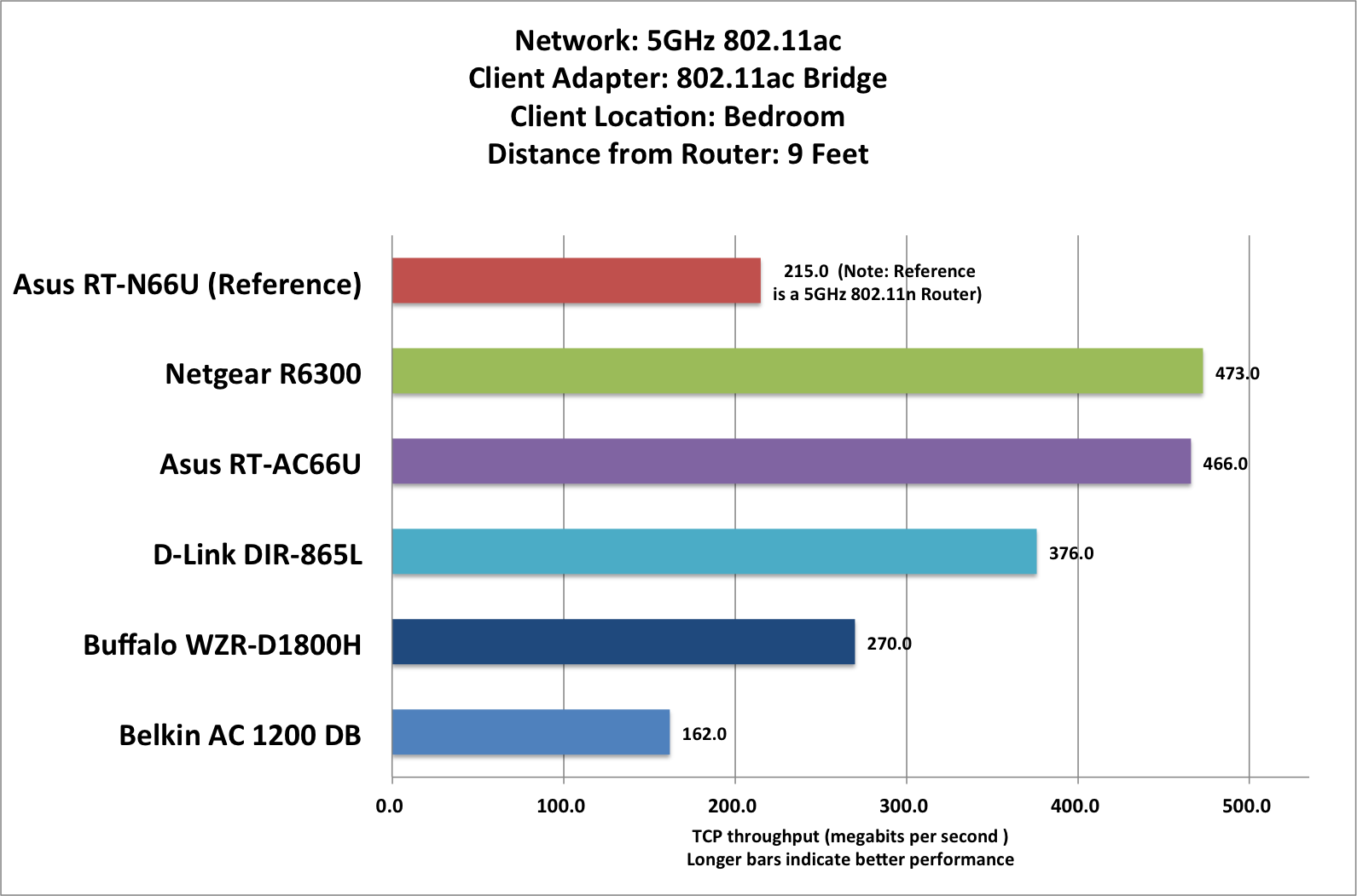
I was surprised to discover that the RT-AC66U performed even better when I moved the client into the kitchen, 20 feet away from the router with one wall in between. I suspect that the media bridge was being oversaturated at the closer proximity, though the orientation of the media bridge is another variable. In the bedroom, the bridge faced the router: In the kitchen, it was perpendicular to the router. Whatever the cause, the RT-AC66U's TCP throughput jumped to a staggering 525 mbps at this location—the fastest performance in the field by a wide margin.

The next two benchmark runs took place inside my home theater. This is a room-within-a-room design, with four walls of 2-by-4 framing and drywall inside four walls of 2-by-6 framing and drywall, with about 6 inches of dead air and fiberglass insulation separating them. My intent was to optimize the room's acoustics, not to build a Faraday cage, but many lesser routers and other wireless devices have had trouble penetrating it. However, none of the 802.11ac routers I tested had any difficulty reaching the client in this room, and three of them—including the RT-AC66U—sustained TCP throughput at more than twice the rate of the reference 802.11n router. As you can see from the chart below, the Asus was the fastest of them all, at 192 mpbs.
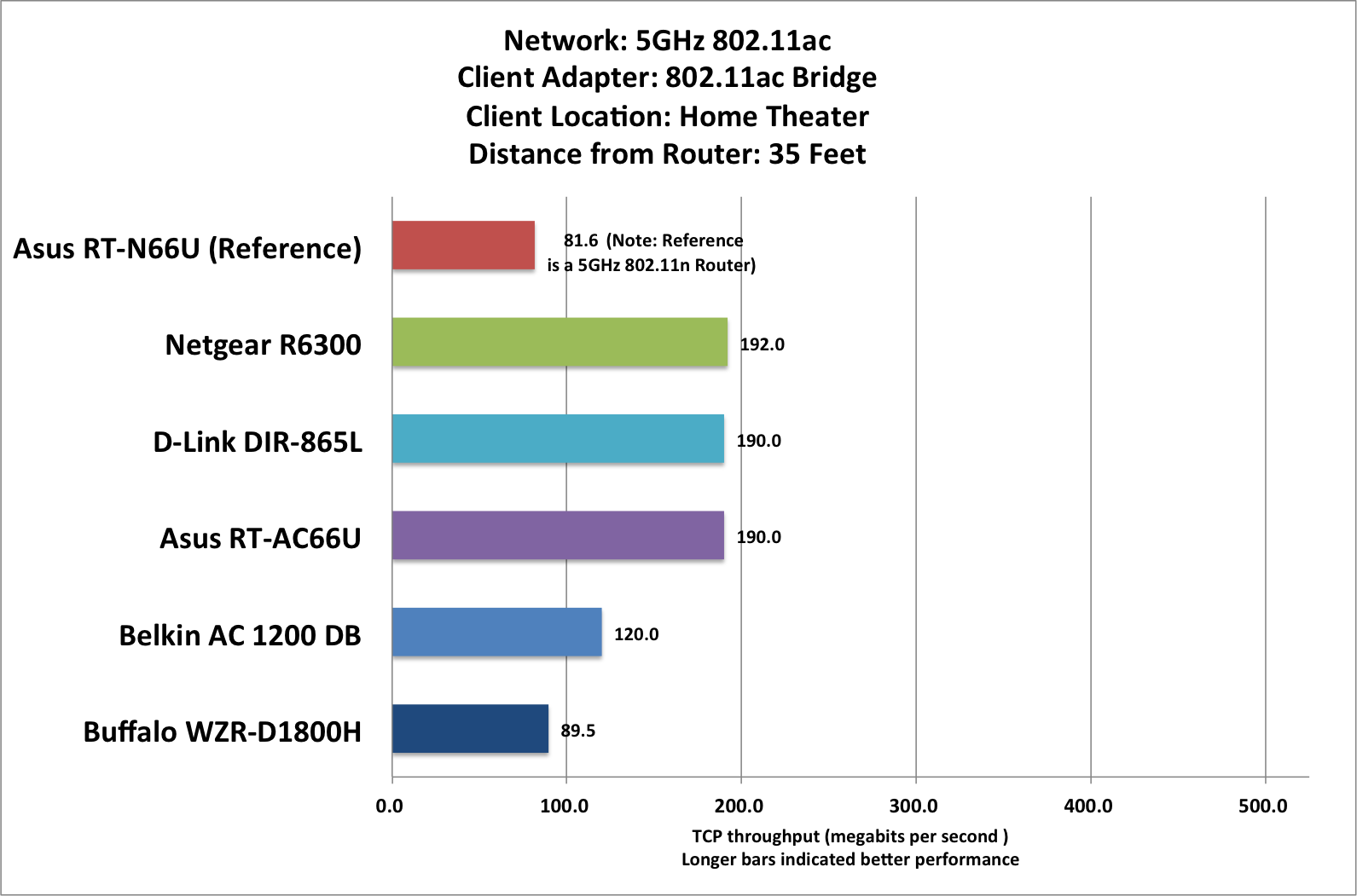
Since many people will want to connect the gear in their home entertainment system to an 802.11ac network, I decided to measure TCP throughput with the media bridge inside the built-in equipment cabinet in my home theater (the floor-to-ceiling, wall-to-wall cabinet is constructed from cabinet-grade plywood, including the back). The RT-AC66U's TCP throughput dropped by just a few megabits per second in this scenario. In fact, I found that I could wirelessly mount and stream a Blu-ray ISO image of the movie Spiderman 3 from a Windows Home Server 2011 machine in my home office to a home theater PC in the entertainment center, including its high-definition soundtrack.

The RT-AC66U's performance dropped off only slightly when I moved the client and the media bridge to the first of my two outdoor locations, an exterior patio enclosed by three walls and one half wall with glass windows. In the real world, I doubt that anyone would try to set up a media bridge outdoors because dragging the bridge and finding an outlet (and likely an extension cord) are too inconvenient. But I wanted to see what kind of range the RT-AC66U would deliver, and I wasn't disappointed. It was the second fastest (behind Netgear's R6300) among the five routers I tested.
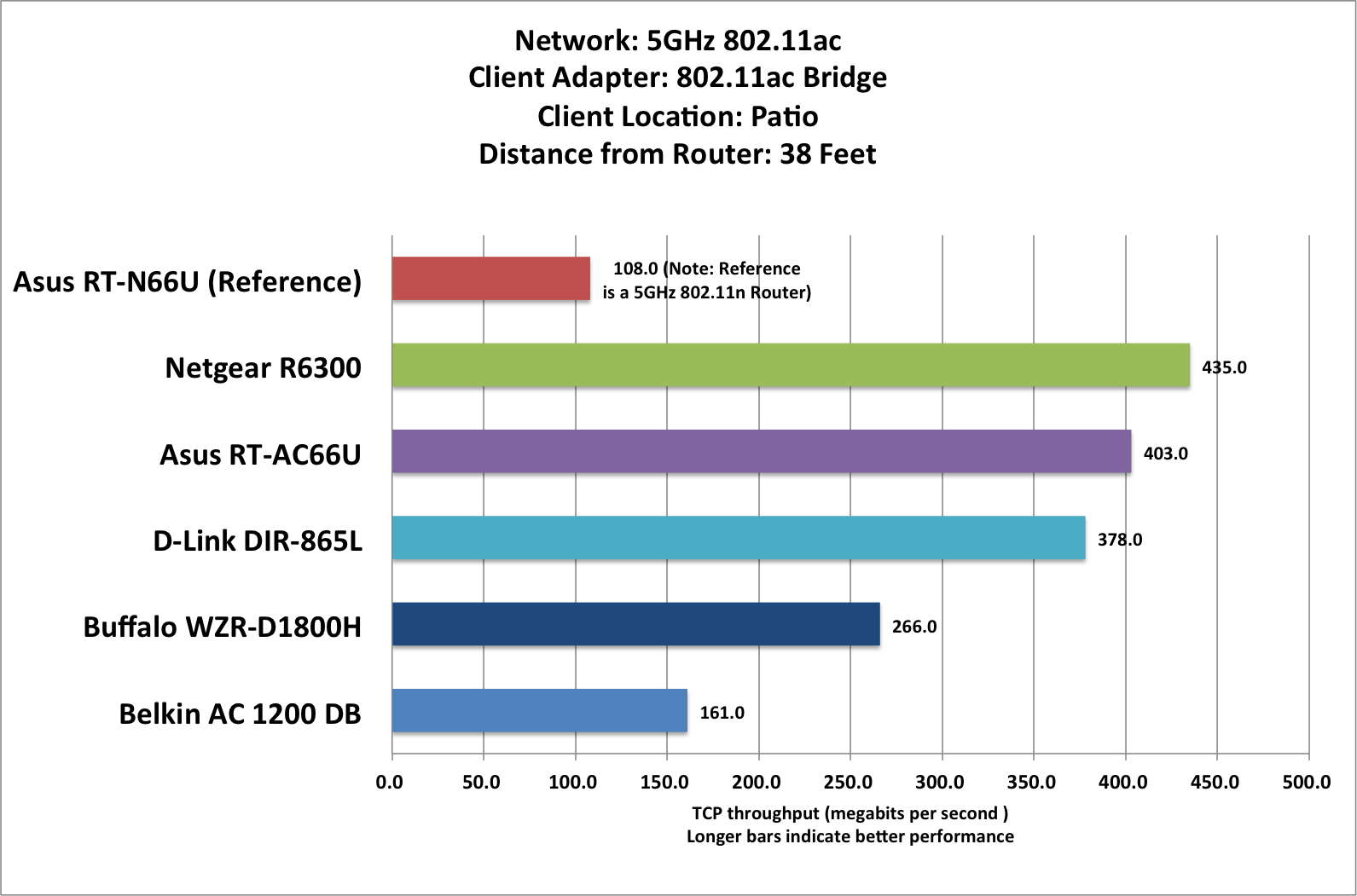
The RT-AC66U's performance was even more impressive when I moved the client and bridge out to a picnic table completely outside my house. At this location, the router and client were 75 feet apart and separated by three insulated interior walls, and one insulated exterior wall clad on one side with fiber-cement lapboard. Under these conditions, the reference 802.11n router delivered TCP throughput of just 30.2 mpbs, but the RT-AC66U roared along at a whopping 125 mbps. The only thing more surprising that the number is the fact that the Asus finished in second place at this location, bested by the D-Link DIR-865L, which delivered 152 mbps.
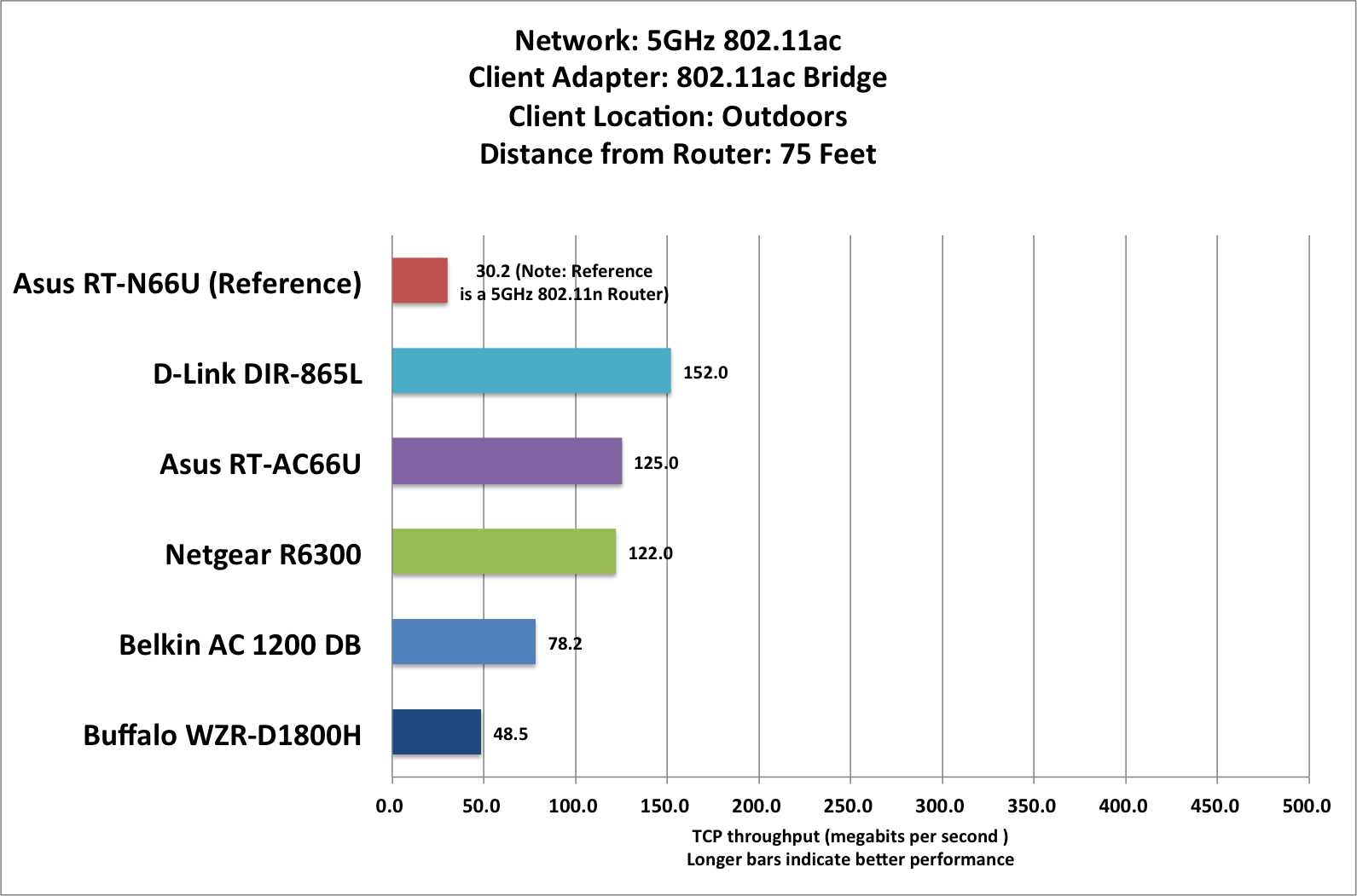
Benchmarking 2.4GHz 802.11n performance
Though you can ostensibly set the router's firmware to forcibly bond two 20MHz channels within the 2.4GHz frequency band to create a single channel with 40MHz of bandwidth, the RT-AC66U automatically backed down to using a single channel when it detected other 2.4GHz wireless networks operating nearby (nevertheless, the router's firmware stubbornly indicated that it was operating a 40-MHz channel).
I assume that this behavior is in preparation for eventual Wi-Fi Alliance certification, since the trade group requires "good-neighbor" behavior of this type, though the Wi-Fi Alliance has not yet implemented a certification program for 802.11ac routers. In my opinion, the router was unnecessarily deferential. My home sits a on a 10-acre lot, and my neighbors' routers are far away. Usually, my network client adapters don't even indicate that the neighboring routers are there at all.
On my 2.4GHz 802.11n benchmark tests, the RT-AC66U performed slightly below the average marks for all five 802.11ac routers, especially at close range (in the bedroom and kitchen tests).
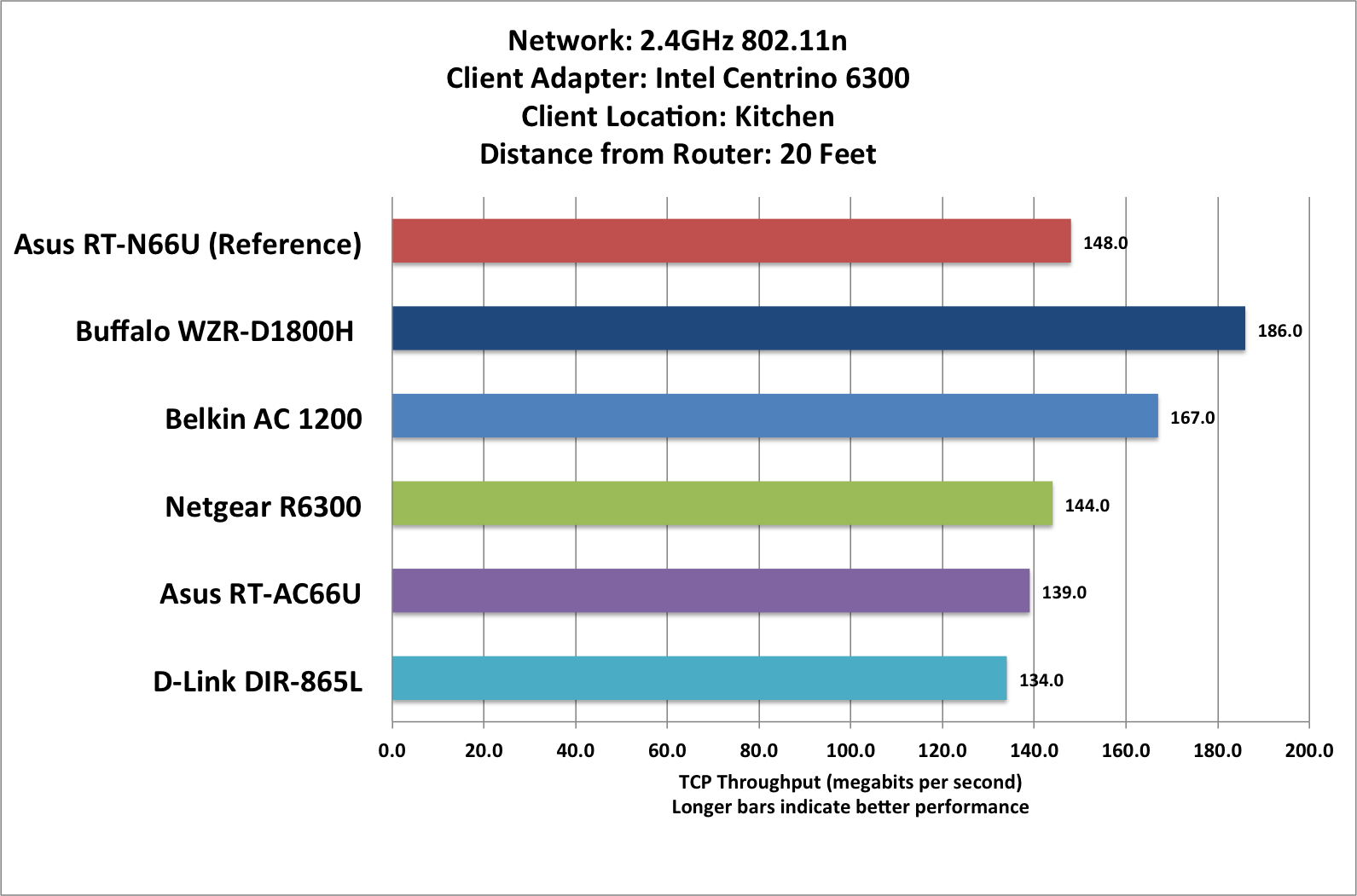
When the distance between the router and the client was greatest, however, the RT-AC66U bested the rest of the field, with the exception of its reference-point cousin, the RT-N66U. In the test charted below, the client and the router were 75 feet apart.
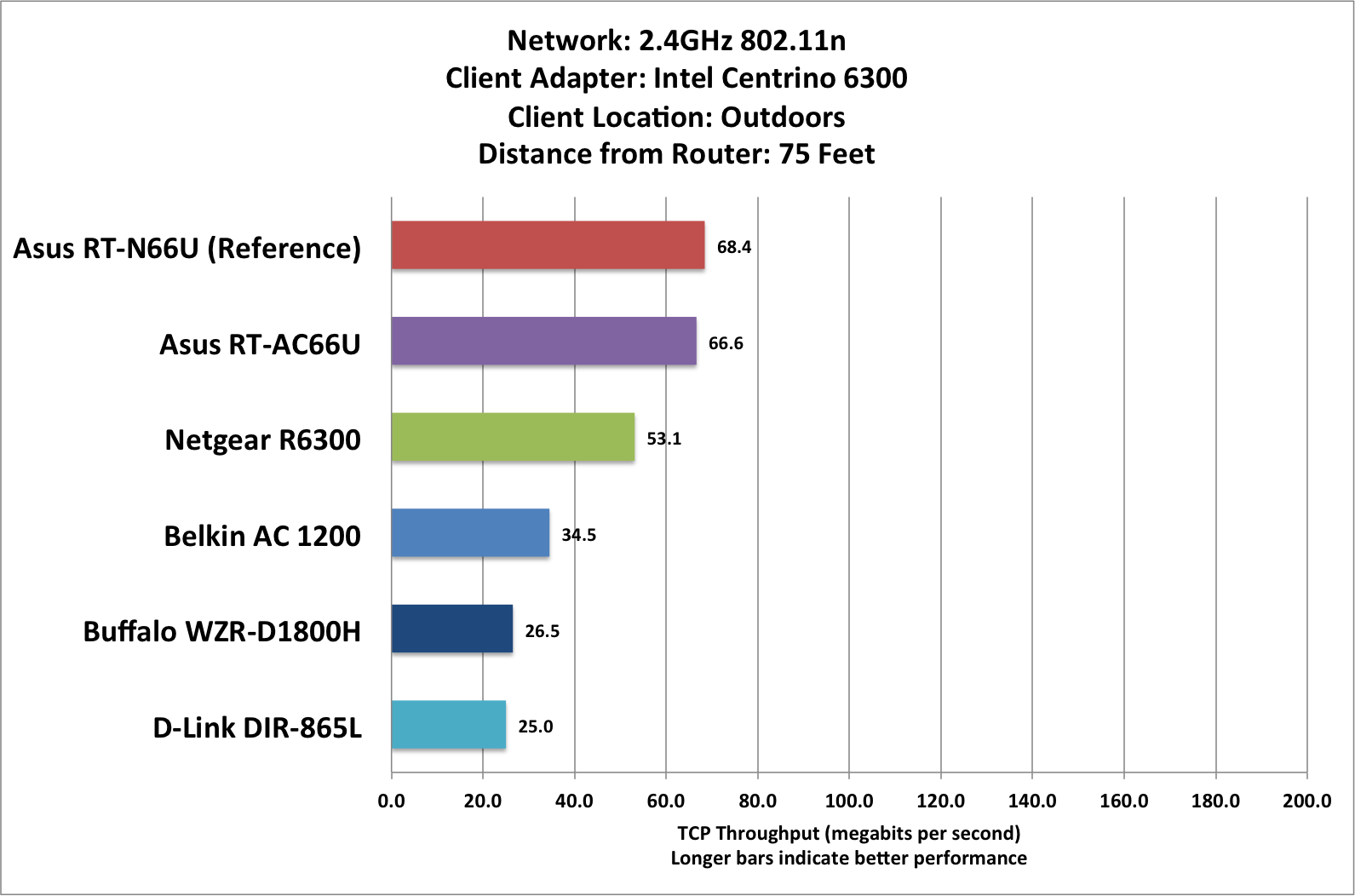
Benchmarking hardwired ethernet performance
The RT-AC66U's four-port gigabit ethernet switch performed as expected, delivering TCP throughput of 943 mbps.
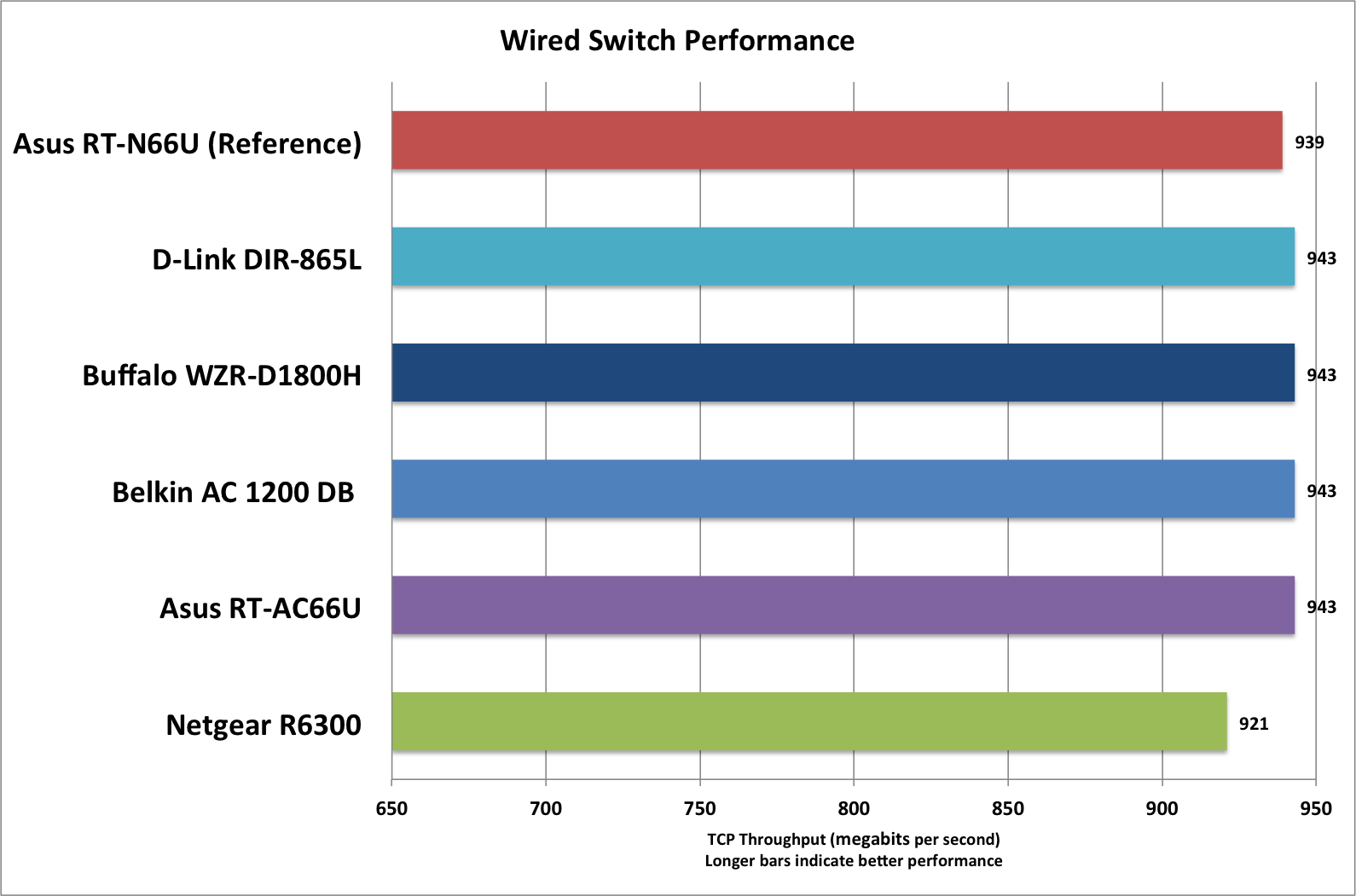
To evaluate the RT-AC66U's performance as a network-attached storage device, I connected a 500GB Western Digital My Passport USB drive to one of the router's USB ports. I used a stopwatch to time how long it took the unit to copy a few files from a PC to the drive over the network (a write test), and then I copied a few files from the USB drive to the networked PC over the network (a read test). The PC was hardwired to the network.
I created a large-file test by ripping a DVD (Quentin Tarantino's From Dusk to Dawn) to the PC's hard drive. Copying this 4.29GB file from the PC to the portable hard drive required 289.7 seconds (about 4 minutes, 50 seconds). This was the fastest time of the five 802.ac routers I tested, but it was slightly slower than the reference RT-N66U 802.11n router. The D-Link and Belkin routers were off the chart here, with scores of 1233 and 2211 seconds, respectively. I couldn't benchmark the Buffalo WZR-D1800H at all on this measure, because the router didn't recognize my NTFS-formatted hard drive.
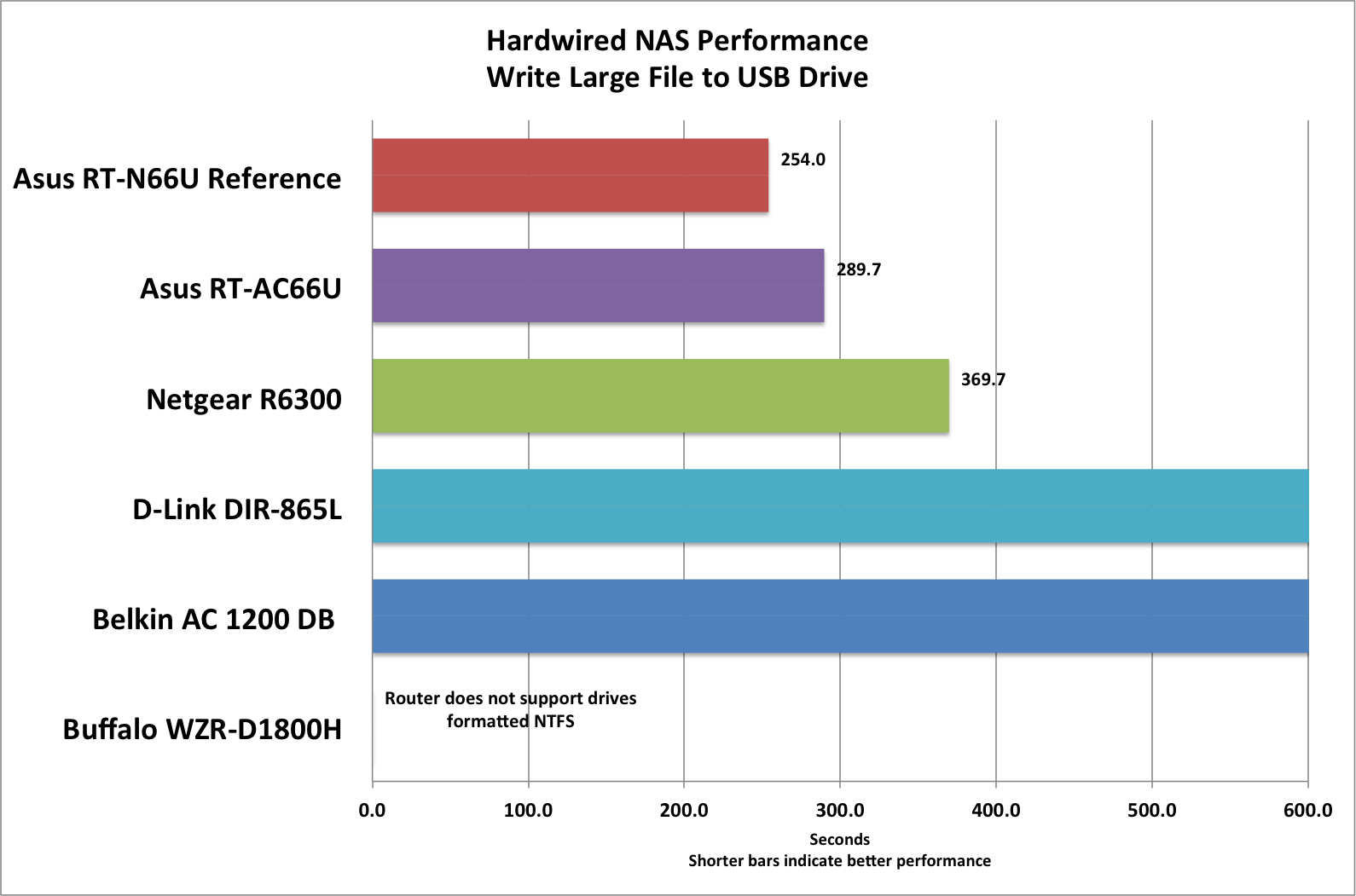
Surprisingly, the RT-AC66U was slower at copying (reading) the large file from the USB drive than it was at writing to the drive. On the other hand, as the chart below makes clear, the two Asus routers were faster than most of the rest of the field on this measure.

Unless you rip a lot of movies from DVD or Blu-ray discs, you'll rarely move a single large file to a hard drive attached to your router. A more common task is to move batches of small files back and forth across your network. To evaluate each router's performance in this scenario, I created a single folder containing 595MB of small files (subfolders containing music, graphics, photos, documents, spreadsheets, and so on).
On this task, the RT-AC66U delivered the fastest write performance of any of the 802.11ac routers I tested; it was bested only by the Asus 802.11n router I used as a reference point.

When it came to retrieving the batch of small files from an attached hard drive, none of the routers were especially fast. The RT-AC66U took third place, behind the reference RT-N66U router and Netgear's R6300 802.11ac router.

Bottom line
Several of the new 802.11ac routers turned in excellent performance on one test or another, but the Asus RT-AC66U was the best overall. It delivered the top benchmark scores performance on two of my 802.11ac wireless tests, two of my 802.11n wireless tests, and nearly all of my hardwired tests (it was part of a three-way tie for first in this category).
The router is feature-rich, too, with DLNA compatibility for home entertainment use, a built-in iTunes server, an integrated BitTorrent client, and more. And Asus has produced an attractive, user-friendly front-end for tweaking its firmware. I wish that more router manufacturers would follow Asus's example of using external antennas that allow users to fine-tune range and performance.
If you're ready to take the plunge into 802.11ac Draft 2.0 and you don't mind paying top dollar, this is the router to buy.
Note: This review is part of a roundup. Click here to read the introduction to the story and find links to the other 802.11ac routers reviewed at the same time.
Update: This story was updated on September 13 to inform readers that Asus has now released the firmware required to make use of its AiCloud tool.
20 Sep, 2012
-
Source: http://www.pcworld.com/article/262149/asus_rt_ac66u_the_best_802_11ac_router_on_the_market_so_far.html
--
Manage subscription | Powered by rssforward.com
Anda sedang membaca artikel tentang
Asus RT-AC66U router review: The best 802.11ac router on the market, so far
Dengan url
http://bakterimakanan.blogspot.com/2012/09/asus-rt-ac66u-router-review-best.html
Anda boleh menyebar luaskannya atau mengcopy paste-nya
Asus RT-AC66U router review: The best 802.11ac router on the market, so far
namun jangan lupa untuk meletakkan link
Asus RT-AC66U router review: The best 802.11ac router on the market, so far
sebagai sumbernya
0 komentar:
Posting Komentar